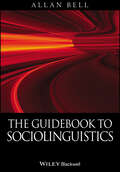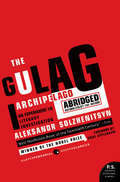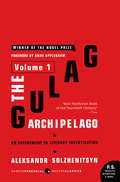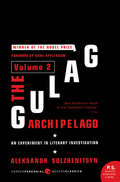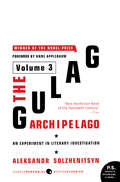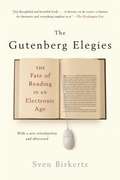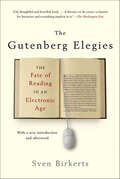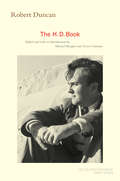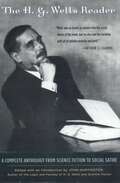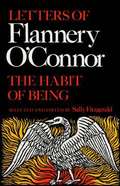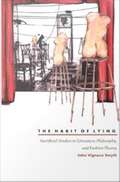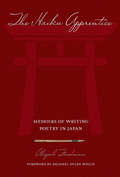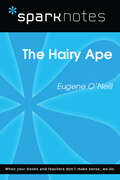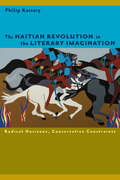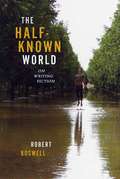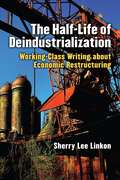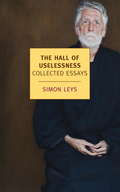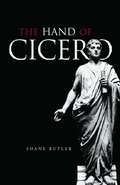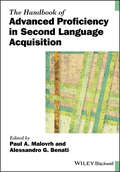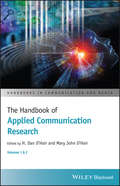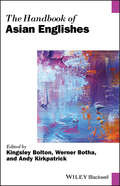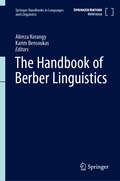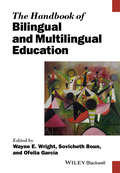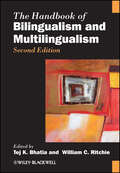- Table View
- List View
The Guidebook to Sociolinguistics (Introducing Linguistics Ser.)
by Allan BellThe Guidebook to Sociolinguistics presents a comprehensive introduction to the main concepts and terms of sociolinguistics, and of the goals, methods, and findings of sociolinguistic research. Introduces readers to the methodology and skills of doing hands-on research in this field Features chapter-by-chapter classic and contemporary case studies, exercises, and examples to enhance comprehension Offers wide-ranging coverage of topics across sociolinguistics. It begins with multilingualism, and moves on through language choice and variation to style and identity Takes students through the challenges involved in conducting their own research project Written by one of the leading figures in sociolinguistics
The Guinea Pig ABC
by Kate DukeEach letter of the alphabet is illustrated by a word which applies to pictured guinea pigs.
The Gulag Archipelago 1918-1956: An Experiment in Literary Investigation (P. S. Ser.)
by Aleksandr I. Solzhenitsyn“BEST NONFICTION BOOK OF THE 20TH CENTURY.” —Time“It is impossible to name a book that had a greater effect on the political and moral consciousness of the late twentieth century.” —David Remnick, The New YorkerThe Nobel Prize winner’s towering masterpiece of world literature, the searing record of four decades of terror and oppression, in one abridged volume (authorized by the author). Features a new foreword by Anne Applebaum.Drawing on his own experiences before, during and after his eleven years of incarceration and exile, on evidence provided by more than 200 fellow prisoners, and on Soviet archives, Solzhenitsyn reveals with torrential narrative and dramatic power the entire apparatus of Soviet repression, the state within the state that once ruled all-powerfully with its creation by Lenin in 1918. Through truly Shakespearean portraits of its victims-this man, that woman, that child-we encounter the secret police operations, the labor camps and prisons, the uprooting or extermination of whole populations, the “welcome” that awaited Russian soldiers who had been German prisoners of war. Yet we also witness astounding moral courage, the incorruptibility with which the occasional individual or a few scattered groups, all defenseless, endured brutality and degradation. And Solzhenitsyn’s genius has transmuted this grisly indictment into a literary miracle.“The greatest and most powerful single indictment of a political regime ever leveled in modern times.” —George F. Kennan“Solzhenitsyn’s masterpiece. . . . The Gulag Archipelago helped create the world we live in today.” —Anne Applebaum, Pulitzer Prize-winning author of Gulag: A History, from the foreword
The Gulag Archipelago Volume 1: An Experiment in Literary Investigation
by Aleksandr I. Solzhenitsyn“BEST NONFICTION BOOK OF THE 20TH CENTURY.” —TimeVolume 1 of the gripping epic masterpiece, Solzhenitsyn's chilling report of his arrest and interrogation, which exposed to the world the vast bureaucracy of secret police that haunted Soviet society. Features a new foreword by Anne Applebaum.“The greatest and most powerful single indictment of a political regime ever leveled in modern times.” —George F. Kennan“It is impossible to name a book that had a greater effect on the political and moral consciousness of the late twentieth century.” —David Remnick, The New Yorker“Solzhenitsyn’s masterpiece. . . . The Gulag Archipelago helped create the world we live in today.” —Anne Applebaum, Pulitzer Prize-winning author of Gulag: A History, from the foreword
The Gulag Archipelago Volume 2: An Experiment in Literary Investigation
by Aleksandr I. Solzhenitsyn“BEST NONFICTION BOOK OF THE 20TH CENTURY.” —TimeVolume 2 of the Nobel Prize-winner’s towering masterpiece: the story of Solzhenitsyn's entrance into the Soviet prison camps, where he would remain for nearly a decade. Features a new foreword by Anne Applebaum.“The greatest and most powerful single indictment of a political regime ever leveled in modern times.” —George F. Kennan“It is impossible to name a book that had a greater effect on the political and moral consciousness of the late twentieth century.” —David Remnick, The New Yorker“Solzhenitsyn’s masterpiece. . . . The Gulag Archipelago helped create the world we live in today.” —Anne Applebaum, Pulitzer Prize-winning author of Gulag: A History, from the foreword
The Gulag Archipelago Volume 3: An Experiment in Literary Investigation
by Aleksandr I. Solzhenitsyn“BEST NONFICTION BOOK OF THE 20TH CENTURY.” —Time <P><P>Volume 3 of the Nobel Prize winner’s towering masterpiece: Solzhenitsyn's moving account of resistance within the Soviet labor camps and his own release after eight years. Features a new foreword by Anne Applebaum. <P><P>“The greatest and most powerful single indictment of a political regime ever leveled in modern times.” —George F. Kennan <P><P>“It is impossible to name a book that had a greater effect on the political and moral consciousness of the late twentieth century.” —David Remnick, New Yorker <P><P>“Solzhenitsyn’s masterpiece. . . . The Gulag Archipelago helped create the world we live in today.” —Anne Applebaum, Pulitzer Prize-winning author of Gulag: A History, from the foreword
The Gutenberg Elegies: The Fate of Reading in an Electronic Age
by Sven BirkertsIn our zeal to embrace the wonders of the Electronic Age, are we sacrificing our literary culture? Birkerts believes the answer is a resounding YES!
The Gutenberg Elegies: The Fate of Reading in an Electronic Age
by Sven Birkerts"[A] THOUGHTFUL AND HEARTFELT BOOK...A literary cri de coeur--a lament for literature and everything implicit in it."--The Washington PostIn our zeal to embrace the wonders of the electronic age, are we sacrificing our literary culture? Renowned critic Sven Birkerts believes the answer is an alarming yes. In The Gutenberg Elegies, he explores the impact of technology on the experience of reading. Drawing on his own passionate, lifelong love of books, Birkerts examines how literature intimately shapes and nourishes the inner life. What does it mean to "hear" a book on audiotape, decipher its words on a screen, or interact with it on CD-ROM? Are books as we know them dead?At once a celebration of the complex pleasures of reading and a boldly original challenge to the new information technologies, The Gutenberg Elegies is an essential volume for anyone who cares about the past and future of books."[A] wise and humane book....He is telling us, in short, nothing less than what reading means and why it matters."--The Boston Sunday Globe"Warmly elegiac...A candid and engaging autobiographical account sketches his own almost obsessive trajectory through avid childhood reading....This profoundly reflexive process is skillfully described."--The New York Times Book Review"Provocative...Compelling...Powerfully conveys why reading matters, why it is both a delight and a necessity."--The Harvard Review
The H.D. Book
by Victor Coleman Robert Duncan Michael BoughnThis magisterial work, long awaited and long the subject of passionate speculation, is an unprecedented exploration of modern poetry and poetics by one of America's most acclaimed and influential postwar poets. What began in 1959 as a simple homage to the modernist poet H.D. developed into an expansive and unique quest to arrive at a poetics that would fuel Duncan's great work in the 1970s. A meditation on both the roots of modernism and its manifestation in the work of H.D., Ezra Pound, D.H. Lawrence, William Carlos Williams, Edith Sitwell, and many others, Duncan's wide-ranging book is especially notable for its illumination of the role women played in creation of literary modernism. Until now, The H.D. Book existed only in mostly out-of-print little magazines in which its chapters first appeared. Now, for the first time published in its entirety, as its author intended, this monumental work--at once an encyclopedia of modernism, a reinterpretation of its key players and texts, and a record of Duncan's quest toward a new poetics--is at last complete and available to a wide audience.
The H.G. Wells Reader: A Complete Anthology from Science Fiction to Social Satire
by John HuntingtonThis collection, the first of its kind, indicates the full breadth of Well's visionary views and social commentary.
The Habit of Being: Letters of Flannery O'Connor
by Flannery O'Connor Sally FitzgeraldThe author has chosen letters of Flannery that presents her tough, funny, careful personality to us.
The Habit of Lying: Sacrificial Studies in Literature, Philosophy, and Fashion Theory
by John Vignaux SmythLying appears to be ubiquitous, what Franz Kafka called "a universal principle"; yet, despite a number of recent books on the subject, it has been given comparatively little genuinely systematic attention by philosophers, social scientists, or even literary theorists. In The Habit of Lying John Vignaux Smyth examines three forms of falsification--lying, concealment, and fiction--and makes a strong critique of traditional approaches to each of them, and, above all, to the relations among them. With recourse to Rene Girard, Paul de Man, Theodor Adorno, Leo Strauss, and other theoreticians not usually considered together, Smyth arrives at some surprising conclusions about the connections between lying, mimesis, sacrifice, sadomasochism, and the sacred, among other central subjects. Arguing that the relation between lying and truthtelling has been characterized in the West by sharply sacrificial features, he begins with a critique of the philosophies of lying espoused by Kant and Sissela Bok, then concludes that the problem of truth and lies leads to the further problem of the relation between law and arbitrariness as well as to the relation between rationality and unanimity. Constructively criticizing the work of such philosophers as Bertrand Russell, Ludwig Wittgenstein, Richard Rorty, and Nelson Goodman, Smyth shows how these problems occur comparably in fiction theory and how Paul de Man's definition of fiction as arbitrariness finds confirmation in analytic philosophy. Through the novels of Defoe, Stendhal, and Beckett--with topics ranging from Defoe's treatment of lies, fiction, and obscenity to Beckett's treatment of the anus and the sacred--Smyth demonstrates how these texts generalize the issues of mendacity, concealment, and sacrificial arbitrariness in Girard's sense to almost every aspect of experience, fiction theory, and cultural life. The final section of the book, taking its cue from Shakespeare, elaborates a sacrificial view of the history of fashion and dress concealment.
The Haiku Apprentice
by Abigail Friedman Michael Dylan WelchThe problem came to a head one day as I was driving through Tokyo. While waiting for the light to change, I saw the following public service announcement on the side of a bus: Omoiyari hitonikurumani konomachini (Sympathy / toward people, toward cars / toward this town). Seventeen syllables. Five-seven-five format. It must be a haiku, I thought. But when I reached the office and repeated the announcement to my Japanese coworkers, none of them thought it was a haiku. I knew they were thinking to themselves, What kind of a lunatic is she? One tried to break the news to me gently, It's not a haiku, it's an advertising jingle. Well, I knew it was an advertising jingle, but still, wasn't it an advertising jingle haiku?--From The Haiku ApprenticeAbigail Friedman was an American diplomat in Tokyo, not a writer. A chance encounter leads her to a haiku group, where she discovers poetry that anyone can enjoy writing. Her teacher and fellow haiku group members instruct her in seasonal flora and fauna, and gradually she learns to describe the world in plain words, becoming one of the millions in Japan who lead a haiku life. This is the author's story of her literary and cultural voyage, and more: it is an invitation to readers to form their own neighborhood haiku groups and, like her, learn to see the world anew."...A deft and seamless merging of genres: at once memoir, travel literature, and an unpretentious guide onto the terrain of Japanese poetry. It will appeal not just to poetry lovers, but to all readers who are curious about the world beyond their own borders." -- Foreword Magazine"Friedman is an appealing guide through an alternate Japan where modern people make poems about teacups and temples but also about skyscrapers and kidney surgery." -- East Bay Express"The book is not designed to make the reader a poet, but it does, perhaps, help us to pay more attention to our poetical eye." -- BiblioBuffet"The Haiku Apprentice gives the reader an original, thoughtful and personal glimpse of one expat's productive encounter with Japan." -- Metropolis "...Notable for its frankness and enthusiasm...Friedman has made a lively narrative out of the things she learned..." -- The Japan Times
The Hairy Ape (SparkNotes Literature Guide Series)
by SparkNotesThe Hairy Ape (SparkNotes Literature Guide) by Eugene O'Neill Making the reading experience fun! Created by Harvard students for students everywhere, SparkNotes is a new breed of study guide: smarter, better, faster.Geared to what today's students need to know, SparkNotes provides:chapter-by-chapter analysis explanations of key themes, motifs, and symbols a review quiz and essay topics Lively and accessible, these guides are perfect for late-night studying and writing papers.
The Haitian Revolution in the Literary Imagination: Radical Horizons, Conservative Constraints (New World Studies)
by Philip KaisaryThe Haitian Revolution (1791–1804) reshaped the debates about slavery and freedom throughout the Atlantic world, accelerated the abolitionist movement, precipitated rebellions in neighboring territories, and intensified both repression and antislavery sentiment. The story of the birth of the world’s first independent black republic has since held an iconic fascination for a diverse array of writers, artists, and intellectuals throughout the Atlantic diaspora. Examining twentieth-century responses to the Haitian Revolution, Philip Kaisary offers a profound new reading of the representation of the Revolution by radicals and conservatives alike in primary texts that span English, French, and Spanish languages and that include poetry, drama, history, biography, fiction, and opera.In a complementary focus on canonical works by Aimé Césaire, C. L. R. James, Edouard Glissant, and Alejo Carpentier in addition to the work of René Depestre, Langston Hughes, and Madison Smartt Bell, Kaisary argues that the Haitian Revolution generated an enduring cultural and ideological inheritance. He addresses critical understandings and fictional reinventions of the Revolution and thinks through how, and to what effect, authors of major diasporic texts have metamorphosed and appropriated this spectacular corner of black revolutionary history.
The Half-Known World: On Writing Fiction
by Robert BoswellA rigorous examination of the workings of fiction by the novelist Robert Boswell, "one of America's finest writers" (Tom Perrotta) Robert Boswell has been writing, reading, and teaching literature for more than twenty years. In this sparkling collection of essays, he brings this vast experience and a keen critical eye to bear on craft issues facing literary writers. Examples from masters such as Leo Tolstoy, Flannery O'Connor, and Alice Munro illustrate this engaging discussion of what makes great writing.At the same time, Boswell moves readers beyond the classroom, candidly sharing the experiences that have shaped his own writing life. A chance encounter in a hotel bar leads to a fascinating glimpse into his imaginative process. And through the story of a boyhood adventure, Boswell details how important it is for writers to give themselves over to what he calls the "half-known world" of fiction, where surprise and meaning converge.
The Half-Life of Deindustrialization: Working-Class Writing about Economic Restructuring (Class : Culture)
by Sherry L LinkonStarting in the late 1970s, tens of thousands of American industrial workers lost jobs in factories and mines. Deindustrialization had dramatic effects on those workers and their communities, but its longterm effects continue to ripple through working-class culture. Economic restructuring changed the experience of work, disrupted people’s sense of self, reshaped local landscapes, and redefined community identities and expectations. Through it all, working-class writers have told stories that reflect the importance of memory and the struggle to imagine a different future. These stories make clear that the social costs of deindustrialization affect not only those who lost their jobs but also their children, their communities, and American culture. Through analysis of poetry, fiction, creative nonfiction, film, and drama, The Half-Life of Deindustrialization shows why people and communities cannot simply “get over” the losses of economic restructuring. The past provides inspiration and strength for working-class people, even as the contrast between past and present highlights what has been lost in the service economy. The memory of productive labor and stable, proud working-class communities shapes how people respond to contemporary economic, social, and political issues. These stories can help us understand the resentment, frustration, pride, and persistence of the American working class.
The Hall of Uselessness
by Simon LeysAn NYRB Classics OriginalSimon Leys is a Renaissance man for the era of globalization. A distinguished scholar of classical Chinese art and literature and one of the first Westerners to recognize the appalling toll of Mao's Cultural Revolution, Leys also writes with unfailing intelligence, seriousness, and bite about European art, literature, history, and politics and is an unflinching observer of the way we live now.The Hall of Uselessness is the most extensive collection of Leys's essays to be published to date. In it, he addresses subjects ranging from the Chinese attitude to the past to the mysteries of Belgium and Belgitude; offers portraits of André Gide and Zhou Enlai; takes on Roland Barthes and Christopher Hitchens; broods on the Cambodian genocide; reflects on the spell of the sea; and writes with keen appreciation about writers as different as Victor Hugo, Evelyn Waugh, and Georges Simenon. Throughout, The Hall of Uselessness is marked with the deep knowledge, skeptical intelligence, and passionate conviction that have made Simon Leys one of the most powerful essayists of our time.
The Hand of Cicero
by Shane ButlerHundreds perished in Rome's Second Proscription, but one victim is remembered above all others. Cicero stands out, however, not only because of his fame, but also because his murder included a unique addition to the customary decapitation. For his corpse was deprived not only of its head, but also of its right hand. Plutarch tells us why Mark Antony wanted the hand that wrote the Philippics. But how did it come to pass that Rome's greatest orator could be so hated for the speeches he had written?Charting a course through Cicero's celebrated career, Shane Butler examines two principal relationships between speech and writing in Roman oratory: the use of documentary evidence by orators and the 'publication' of both delivered and undelivered speeches. He presents this fascinating theory that the success of Rome's greatest orator depended as much on writing as speaking; he also argues against the conventional wisdom that Rome was an 'oral society', in which writing was rare and served only practical, secondary purposes.
The Handbook of Advanced Proficiency in Second Language Acquisition (Blackwell Handbooks in Linguistics)
by Alessandro G. Benati Paul A. MalovrhA comprehensive, current review of the research and approaches to advanced proficiency in second language acquisition The Handbook of Advanced Proficiency in Second Language Acquisition offers an overview of the most recent and scientific-based research concerning higher proficiency in second language acquisition (SLA). With contributions from an international team of experts in the field, the Handbook presents several theoretical approaches to SLA and offers an examination of advanced proficiency from the viewpoint of various contexts and dimensions of second language performance. The authors also review linguistic phenomena among advanced learners through the lens of phonology and grammar development. Comprehensive in scope, this book provides an overview of advanced proficiency grounded in socially-relevant domains of second language acquisition including discourse, reading, genre-based writing, and pragmatic competence. The authoritative volume brings together the theoretical accounts of advanced language use combined with solid empirical research. Includes contributions from an international collection of noted scholars in the field of second language acquisition Offers a variety of theoretical approaches to SLA Contains information on the most recent empirical research that contributes to an understanding of SLA Describes performance phenomena according to multiple approaches to SLA Written for scholars, students and linguists, The Handbook of Advanced Proficiency in Second Language Acquisition is a comprehensive text that offers the most recent developments in the study of advanced proficiency in the acquisition of a second language.
The Handbook of Applied Communication Research (Handbooks in Communication and Media)
by H. Dan O’Hair Mary John O’HairAn authoritative survey of different contexts, methodologies, and theories of applied communication The field of Applied Communication Research (ACR) has made substantial progress over the past five decades in studying communication problems, and in making contributions to help solve them. Changes in society, human relationships, climate and the environment, and digital media have presented myriad contexts in which to apply communication theory. The Handbook of Applied Communication Research addresses a wide array of contemporary communication issues, their research implications in various contexts, and the challenges and opportunities for using communication to manage problems. This innovative work brings together the diverse perspectives of a team of notable international scholars from across disciplines. The Handbook of Applied Communication Research includes discussion and analysis spread across two comprehensive volumes. Volume one introduces ACR, explores what is possible in the field, and examines theoretical perspectives, organizational communication, risk and crisis communication, and media, data, design, and technology. The second volume focuses on real-world communication topics such as health and education communication, legal, ethical, and policy issues, and volunteerism, social justice, and communication activism. Each chapter addresses a specific issue or concern, and discusses the choices faced by participants in the communication process. This important contribution to communication research: Explores how various communication contexts are best approached Addresses balancing scientific findings with social and cultural issues Discusses how and to what extent media can mitigate the effects of adverse events Features original findings from ongoing research programs and original communication models and frameworks Presents the best available research and insights on where current research and best practices should move in the future A major addition to the body of knowledge in the field, The Handbook of Applied Communication Research is an invaluable work for advanced undergraduate students, graduate students, and scholars.
The Handbook of Asian Englishes (Blackwell Handbooks in Linguistics)
by Andy Kirkpatrick Kingsley Bolton Werner BothaThe first volume of its kind, focusing on the sociolinguistic and socio-political issues surrounding Asian Englishes The Handbook of Asian Englishes provides wide-ranging coverage of the historical and cultural context, contemporary dynamics, and linguistic features of English in use throughout the Asian region. This first-of-its-kind volume offers a wide-ranging exploration of the English language throughout nations in South Asia, Southeast Asia, and East Asia. Contributions by a team of internationally-recognized linguists and scholars of Asian Englishes and Asian languages survey existing works and review new and emerging areas of research in the field. Edited by internationally renowned scholars in the field and structured in four parts, this Handbook explores the status and functions of English in the educational institutions, legal systems, media, popular cultures, and religions of diverse Asian societies. In addition to examining nation-specific topics, this comprehensive volume presents articles exploring pan-Asian issues such as English in Asian schools and universities, English and language policies in the Asian region, and the statistics of English across Asia. Up-to-date research addresses the impact of English as an Asian lingua franca, globalization and Asian Englishes, the dynamics of multilingualism, and more. Examines linguistic history, contemporary linguistic issues, and English in the Outer and Expanding Circles of Asia Focuses on the rapidly-growing complexities of English throughout Asia Includes reviews of the new frontiers of research in Asian Englishes, including the impact of globalization and popular culture Presents an innovative survey of Asian Englishes in one comprehensive volume Serving as an important contribution to fields such as contact linguistics, World Englishes, sociolinguistics, and Asian language studies, The Handbook of Asian Englishes is an invaluable reference resource for undergraduate and graduate students, researchers, and instructors across these areas.
The Handbook of Berber Linguistics (Springer Handbooks in Languages and Linguistics)
by Alireza Korangy Karim BensoukasThis handbook is the largest and most comprehensive publication on Berber linguistics to date, covering the variety of Berber dialects and related linguistics trends. Extensive and diverse at thematic and theoretical levels, with the aim of deepening students and scholars' understanding of the workings of Berber as a linguistic phenomenon, it explores a multitude of angles through which the diachronic and synchronic intricacies of Berber varieties can be examined. It enables a better understanding of the issues in the various components of North African languages, as well as their theoretical and typological significance and implications. The work covers phonology and phonetics, morphology and syntax, semantics and pragmatics, socio-linguistics and dialectology, language teaching and psycholinguistics, lexicology, language contact and comparative linguistics, historical linguistics and etymology. Sub-themes explored include prosody, ideophones (and expressive language in general), morpho-syntactic categories, sociolinguistic variation and several other seminal interdisciplinary explorations. The chapters reflect the diversity of Berber varieties and include up-to-date scholarship by leading Berberists, with varieties including Figuig, Kabyle, Senhaja, Siwa, Standard Moroccan Amazigh, Tamazight, Tarifit, Tashlhit, Touareg, Tunisian Berber, Znaga, as well as Proto-Berber. A large geographical territory is covered, including Algeria, Egypt, Libya, Mali, Mauritania, Morocco, and Tunisia. With contributions from these Berber-speaking countries and their diaspora, there are also chapters from prominent Berber scholars from America, Australia and Europe. To this end, the volume includes perspectives and theories from different schools of linguistics. In including original French contributions and English translations of research from top scholars in the field, the book includes another vital dimension in terms ofthe resources, and sources. As a comprehensive reference, this work is of interest to North Africanists from various disciplines, including anthropologists, linguists, and sociologists, but particularly linguists interested in endangered languages, and those working on the historical and comparative study of the Afroasiatic language phylum.
The Handbook of Bilingual and Multilingual Education (Blackwell Handbooks in Linguistics)
by Ofelia García Wayne E. Wright Sovicheth BounThe Handbook of Bilingual and Multilingual Education presents the first comprehensive international reference work of the latest policies, practices, and theories related to the dynamic interdisciplinary field of bilingual and multilingual education. Represents the first comprehensive reference work that covers bilingual, multilingual, and multicultural educational policies and practices around the world Features contributions from 78 established and emerging international scholars Offers extensive coverage in sixteen chapters of language and education issues in specific and diverse regional/geographic contexts, including South Africa, Mexico, Latvia, Cambodia, Japan, and Texas Covers pedagogical issues such as language assessment as well as offering evolving perspectives on the needs of specific learner populations, such as ELLs, learners with language impairments, and bilingual education outside of the classroom
The Handbook of Bilingualism and Multilingualism (Blackwell Handbooks in Linguistics)
by William C. Ritchie Tej K. Bhatia**Honored as a 2013 Choice Outstanding Academic Title**Comprising state-of-the-art research, this substantially expanded and revised Handbook discusses the latest global and interdisciplinary issues across bilingualism and multilingualism. Includes the addition of ten new authors to the contributor team, and coverage of seven new topics ranging from global media to heritage language learning Provides extensively revised coverage of bilingual and multilingual communities, polyglot aphasia, creolization, indigenization, linguistic ecology and endangered languages, multilingualism, and forensic linguistics Brings together a global team of internationally-renowned researchers from different disciplines Covers a wide variety of topics, ranging from neuro- and psycho-linguistic research to studies of media and psychological counseling Assesses the latest issues in worldwide linguistics, including the phenomena and the conceptualization of 'hyperglobalization', and emphasizes geographical centers of global conflict and commerce
